Main menu
Common skin conditions

NEWS
Join DermNet PRO
Read more
Quick links
Atopic hand dermatitis — extra information
Introduction Demographics Causes Clinical features Variation in skin types Complications Diagnosis Differential diagnoses Treatment Outcome
What is atopic hand dermatitis?
Atopic hand dermatitis (also known as atopic hand eczema) is a multifactorial inflammatory condition affecting the fingers, hands, and wrists of an atopic individual. Atopic dermatitis is the most important risk factor for chronic hand dermatitis.
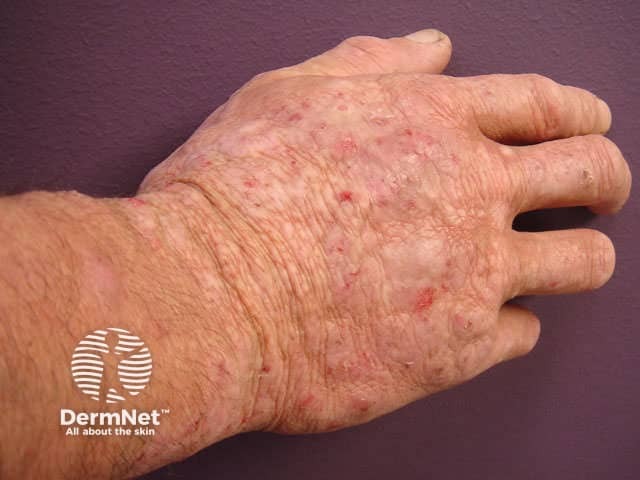
Atopic dermatitis
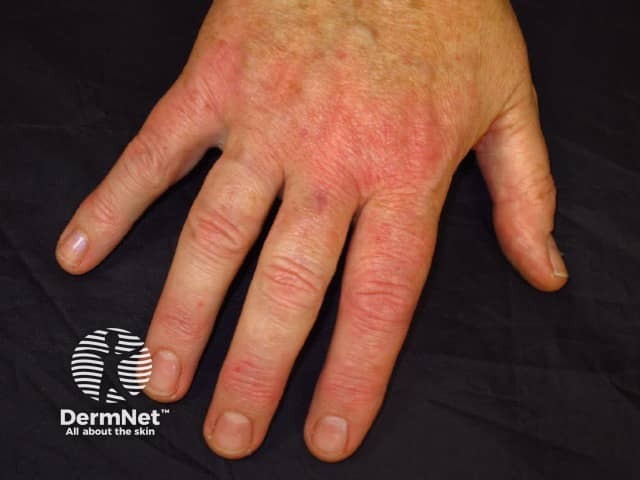

See more atopic hand dermatitis pictures
Who gets atopic hand dermatitis?
Atopic hand dermatitis occurs in at least 50–60% of people with active atopic dermatitis, including children. The prevalence of hand involvement increases with age, with hand dermatitis detected in 30–40% of atopic babies and toddlers (age 0–2 years), 55% of atopic children aged 3–12 years, and 65% in those aged over 12 years. This is probably due to increased exposure to irritants. Two-thirds of patients report developing hand dermatitis within one year of the onset of the atopic dermatitis.
What causes atopic hand dermatitis?
Atopic hand dermatitis is multifactorial with inherited and environmental factors contributing to skin barrier dysfunction and immune system dysregulation.
Skin barrier function in atopic dermatitis is impaired due to a deficiency in or defective function of filaggrin, increasing transepidermal water loss (TEWL), and the risk of contact dermatitis and infection.
Atopic hand dermatitis has increased Th2 activation and production of IL-4, IL-13, IL-31, CCL17, CCL18 and CCL22.
Irritant contact dermatitis more commonly complicates atopic hand dermatitis than allergic contact dermatitis. Water exposure is a frequent trigger reported to aggravate atopic hand dermatitis.
Irritant contact dermatitis complicating atopic hand dermatitis
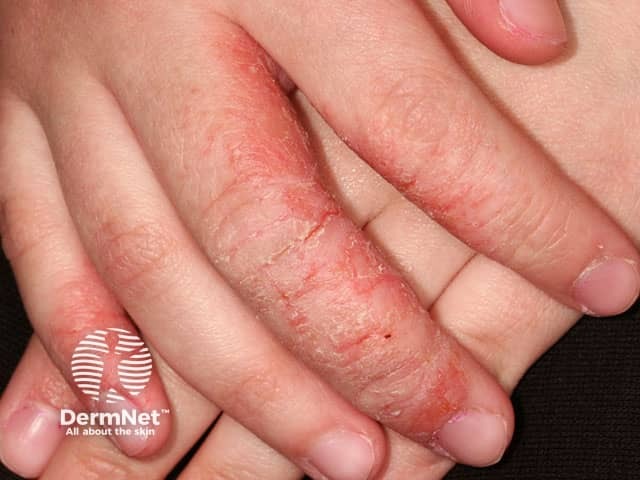
Atopic irritant hand dermatitis
What are the clinical features of atopic hand dermatitis?
Atopic hand dermatitis preferentially affects the backs of the hands (90%) and fingers (70%), and both aspects of the wrists (50-60%). Involvement of the palmar aspect of the hands and fingers is less common (30%). Atopic hand dermatitis commonly presents with pruritus and dryness, but may include other symptoms such as stinging, burning, and pain. Vesicular hand dermatitis or nummular dermatitis are uncommon presentations. Weeping and crusting can affect the skin surface.
Atopic hand dermatitis distribution patterns
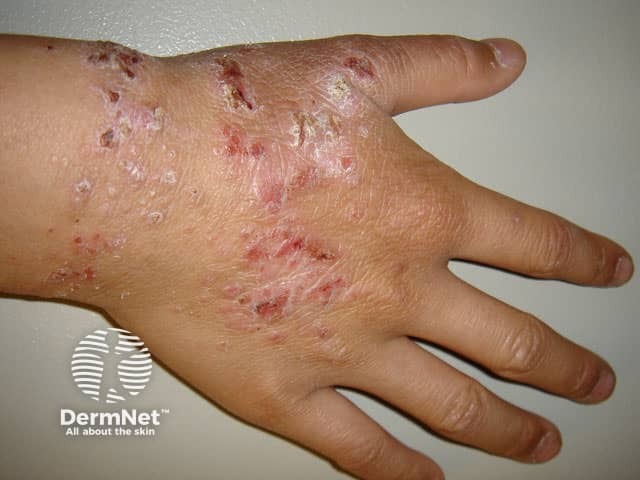
Chronic lichenified atopic hand dermatitis on the back of the hand and wrist
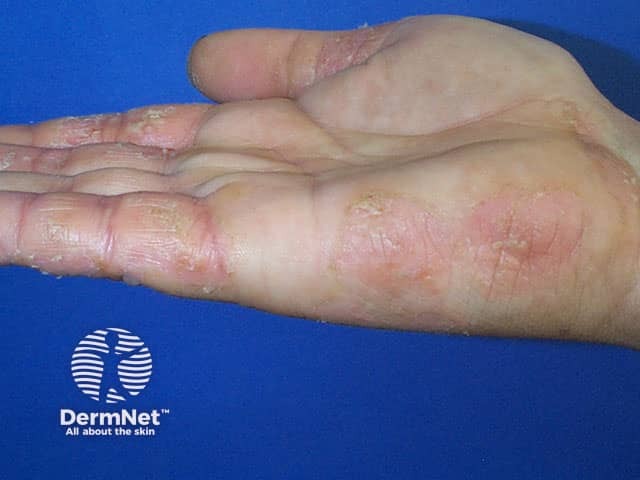
Atopic hand dermatitis involving the palmar aspect of the fingers and side of hand
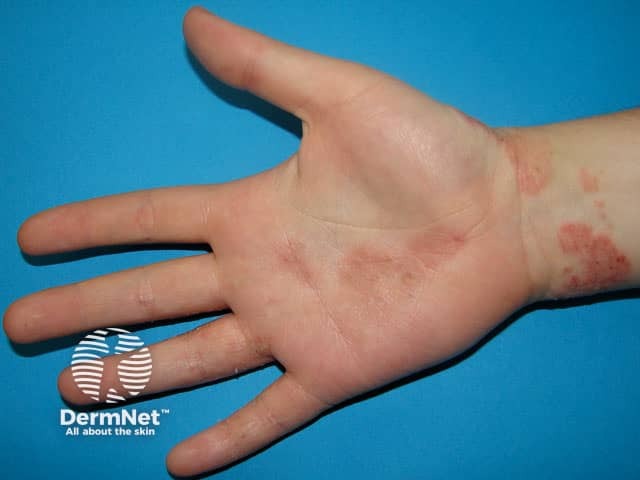
Atopic hand dermatitis involving the volar wrist and palm of hand
Clinical signs include:
- Acute atopic hand dermatitis — erythema, oedema, intensely itchy or burning vesiculation, xerosis
- Chronic atopic hand dermatitis — persistent erythema, hyperkeratosis, lichenification, pain or stinging, fissuring.
However, there are no specific morphological features to distinguish hand dermatitis due to atopic dermatitis from other aetiologies, although the distribution may give a clue. Skin signs that suggest atopic hand dermatitis include hyperlinear palms, keratosis pilaris, and changes of atopic dermatitis elsewhere.
Clues to the diagnosis of atopic dermatitis
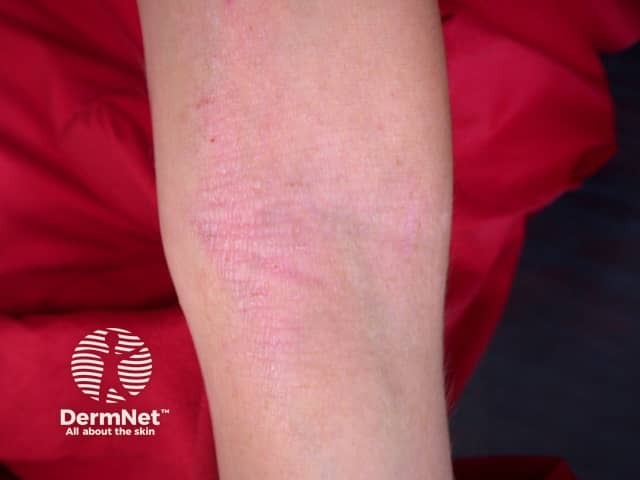
Atopic dermatitis: flexural involvement
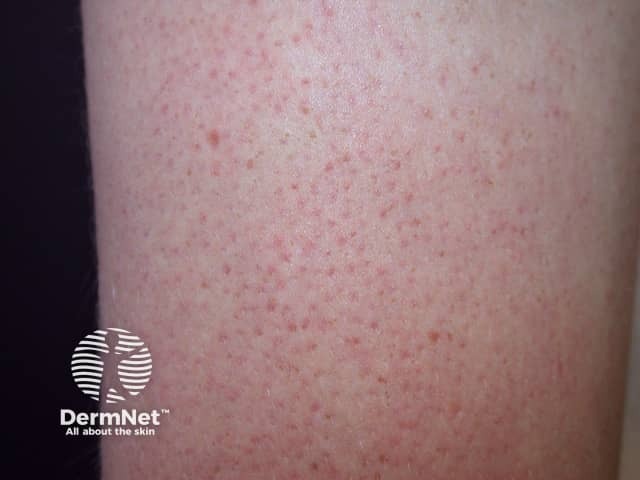
Atopic dermatitis: keratosis pilaris

Atopic dermatitis: hyperlinear palm
Nail changes associated with dermatitis involving the distal fingers include coarse pitting, transverse ridges/grooves, and loss of cuticle.
Nail changes associated with atopic hand dermatitis
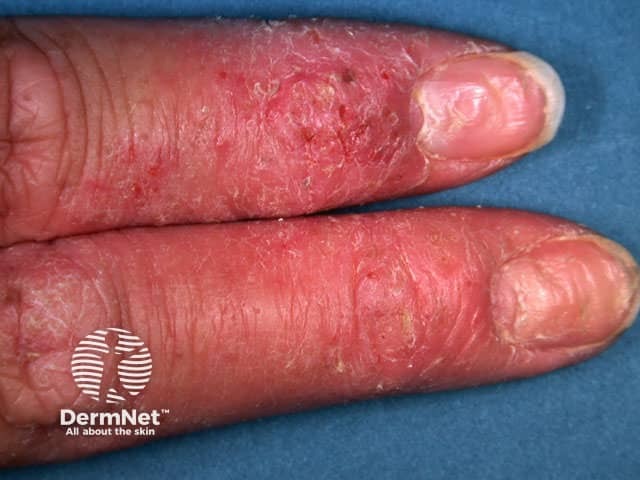
Transverse nail ridging with atopic dermatitis of the distal fingers
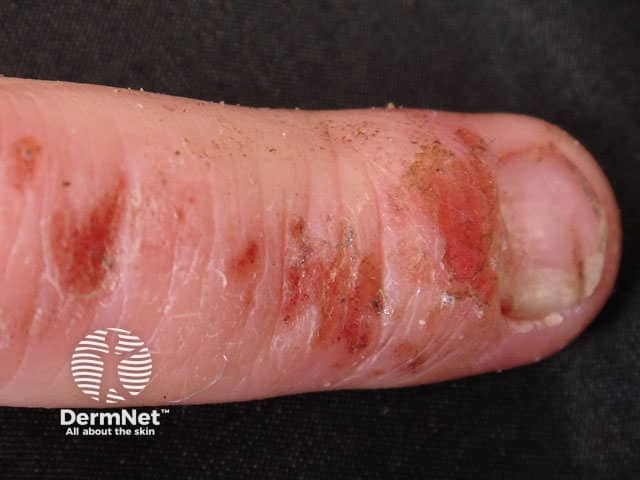
Atopic dermatitis on the finger with nail changes
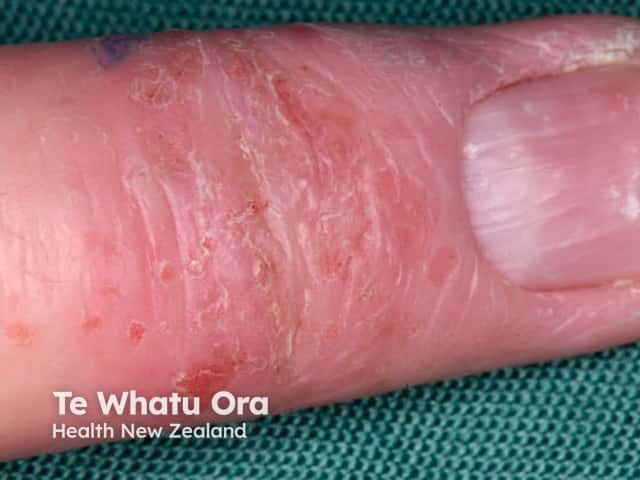
Longitudinal nail ridging and pitting with atopic dermatitis of the distal finger
How do clinical features vary in differing types of skin?
Atopic hand dermatitis in skin of colour shows less obvious erythema and more postinflammatory hyperpigmentation than in white skin, and the overlying scale is often a grey colour.
What are the complications of atopic hand dermatitis?
- Secondary bacterial infection due to Staphylococcus aureus [see Staphylococcal skin infections]
- Psychosocial complications — including impaired quality of life, sick days, loss of work, and inability to perform specific tasks [see Psychological effects of atopic dermatitis]
- Occupational skin disease.
[see also Complications of atopic dermatitis]
How is atopic hand dermatitis diagnosed?
Atopic hand dermatitis is usually a clinical diagnosis based on a history of atopy and exclusion of other diagnoses. Assessment should include looking for aggravating factors such as exposure to irritants and allergens at home and at work.
Investigations may include:
- Total serum IgE if a diagnosis of atopy is not clear
- Skin swabs for bacteriology [see Laboratory tests for bacterial infection]
- Skin scrapings for fungal microscopy and culture [see Laboratory tests for fungal infection]
- Patch tests for possible allergic contact dermatitis
- Skin prick testing and specific IgE tests for possible protein contact dermatitis such as latex allergy
- Skin biopsy is rarely useful.
What is the differential diagnosis for atopic hand dermatitis?
- Hand dermatitis of various types [see Hand dermatitis] including hyperkeratotic palmar dermatitis
- Psoriasis of palms and soles
- Tinea manuum.
What is the treatment for atopic hand dermatitis?
General measures
Obsessive hand care is essential and is required long-term to minimise recurrence or flares due to environmental factors. Advice should be sought before commencing work in an occupation involving wet work or exposure to chemicals such as hairdressing or healthcare.
- Minimise exposure to irritants including water, soap, and detergents
- Minimise ‘wet work’
- Hand hygiene — alcohol-based hand sanitisers with glycerine are less irritating than soap and water
- Frequent application of simple unperfumed hand emollients [see Emollients and moisturisers]
- Gloves should be worn for all wet or dirty work at home and in the workplace. [see Gloves for hand protection].
Topical treatments
- Potent or super-potent topical steroids
- Topical calcineurin inhibitors
- Coal tar treatment
- Janus kinase inhibitors — delgocitinib is in the clinical trial stage.
Phototherapy
- Localised narrowband UVB phototherapy using a hand-and-foot machine
- UVA1 phototherapy
- Photochemotherapy.
Systemic therapy
For severe or treatment-refractory atopic hand dermatitis:
- Immunosuppressant drugs include short-term systemic corticosteroid, methotrexate, azathioprine, ciclosporin, mycophenolate mofetil; however, use for atopic hand dermatitis may be off-label
- Oral retinoids — adverse effects tend to outweigh the clinical benefits when treating chronic hand dermatitis – alitretinoin [see also Key clinical-trial evidence for alitretinoin] is approved in Europe, Canada, Israel, and South Korea for hand dermatitis, acitretin
- Biological treatments — dupilumab [see also Key clinical-trial evidence about dupilumab] and lebrikizumab.
What is the outcome for atopic hand dermatitis?
Prompt treatment is recommended as hand dermatitis tends to become chronic. Patients are particularly prone to developing irritant contact dermatitis, but have the same risk of developing allergic contact dermatitis as the general population. Moderate to severe dermatitis is a strong predictor of persistent disease.
Bibliography
- Coenraads PJ. Hand eczema. N Engl J Med. 2012;367(19):1829–37. doi:10.1056/NEJMcp1104084. PubMed
- Dubin C, Del Duca E, Guttman-Yassky E. Drugs for the treatment of chronic hand eczema: successes and key challenges [published correction appears in Ther Clin Risk Manag. 2021 Mar 18;17:233]. Ther Clin Risk Manag. 2020;16:1319–32. doi:10.2147/TCRM.S292504. Journal
- Giwercman C, Lerbaek A, Bisgaard H, Menné T. Classification of atopic hand eczema and the filaggrin mutations. Contact Dermatitis. 2008;59(5):257–60. doi:10.1111/j.1600-0536.2008.01426.x. Journal
- Halling-Overgaard AS, Zachariae C, Thyssen JP. Management of atopic hand dermatitis. Dermatol Clin. 2017;35(3):365–72. doi:10.1016/j.det.2017.02.010. PubMed
- Menné T, Johansen JD, Sommerlund M, Veien NK; Danish Contact Dermatitis Group. Hand eczema guidelines based on the Danish guidelines for the diagnosis and treatment of hand eczema. Contact Dermatitis. 2011;65(1):3–12. doi:10.1111/j.1600-0536.2011.01915.x. PubMed
- Oosterhaven JAF, Voorberg AN, Romeijn GLE, de Bruin-Weller MS, Schuttelaar MLA. Effect of dupilumab on hand eczema in patients with atopic dermatitis: an observational study. J Dermatol. 2019;46(8):680–5. doi:10.1111/1346-8138.14982. PubMed Central
- Simpson EL, Thompson MM, Hanifin JM. Prevalence and morphology of hand eczema in patients with atopic dermatitis. Dermatitis. 2006;17(3):123–7. doi:10.2310/6620.2006.06005. PubMed
On DermNet
Other websites
- British Association of Dermatologists
- Eczema Association of Australia Inc.
- Eczema Association of New Zealand
- Atopic dermatitis — American Academy of Dermatology
- Chronic hand eczema — AHA! Swiss Allergy Centre
- Hand eczema — Occupational Dermatology Research and Education Centre, Australia
